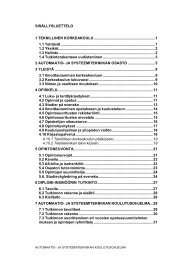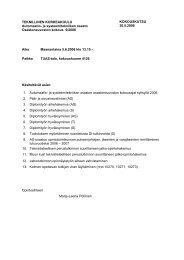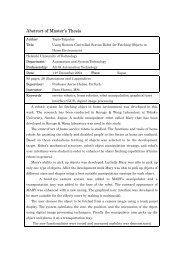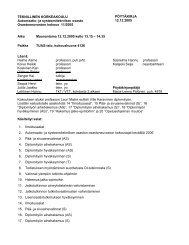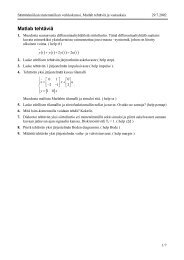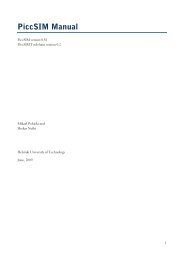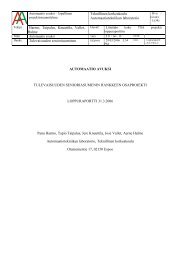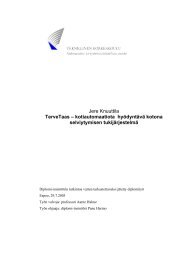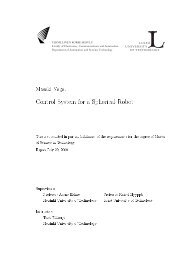fem modelling of a bellows and a bellows- based micromanipulator
fem modelling of a bellows and a bellows- based micromanipulator
fem modelling of a bellows and a bellows- based micromanipulator
Create successful ePaper yourself
Turn your PDF publications into a flip-book with our unique Google optimized e-Paper software.
FEM <strong>modelling</strong> <strong>of</strong> a <strong>bellows</strong> <strong>and</strong> a <strong>bellows</strong>-<strong>based</strong> <strong>micromanipulator</strong>III. ModellingQ parameter [mN mm 2 ]82762.1082762.0582762.0082761.9582761.9082761.85Bending parameter Q for the whole <strong>bellows</strong>Constant pressure p = 20 [mN/mm 2 ]82761.8010 15 20 25 30 35 40 45 50Force [mN]The Q value doesn't vary more than 0,002% in the full range <strong>of</strong> bending force. It means thatthe <strong>bellows</strong>' inclination depends in a very linear way on the applied force. The mean value <strong>of</strong>those results – which is 82,77·10 3 [mN·mm 2 ] – differs less than 0,6% <strong>of</strong> the value determinedearlier.3.4 Pressure vs axial displacementThe previous parameters acquired were so called passive parameters, since they don't reallyact on the <strong>bellows</strong>, but are just some kind <strong>of</strong> response when applying external loads – asbending force, or as a mass. They are necessary to settle the correct behaviour <strong>of</strong> the <strong>bellows</strong>acting together, <strong>and</strong> to build the whole <strong>micromanipulator</strong> beam-<strong>based</strong> model.From the viewpoint <strong>of</strong> the comm<strong>and</strong>, there are also other important elements that have to bedetermined. Since the <strong>micromanipulator</strong> is only controlled by the voltage applied on the threepiezoelectric actuators, it is important to get now the different parameters entering at stakethrough the whole motion-process <strong>of</strong> one <strong>bellows</strong>:y cControly c ë VvoltagePiezosV ë ppressureBellowsp ë yyFigure 22Motion-process <strong>of</strong> the<strong>micromanipulator</strong>: y c is the desiredposition <strong>of</strong> the <strong>bellows</strong>' top, <strong>and</strong> yits reached position.In this project, the point <strong>of</strong> interest is <strong>of</strong> course only the <strong>bellows</strong>. Therefore, the lastparameter to be found now is the conversion constant Z between the pressure applied by thepiezoactuator <strong>and</strong> the axial motion <strong>of</strong> the <strong>bellows</strong>.Hence, the next simulation will be the same as the one used for the comparison between thethree different models (figure 18). For a more accurate answer, the 3D model with SOLID45-elements is used. But this time, a time-varying internal pressure is applied into the ring, sothat it can also be checked if Z is really constant over the entire pressure range. It can also beseen if the radial displacement is truly negligible, as the manufacturer suggests.Inasmuch as only a lone ring simulation was considered, care has to be taken about whichnode should be observed during the measurements. The upper-part <strong>of</strong> the ring can movefreely, <strong>and</strong> that's actually not exactly the case <strong>of</strong> each ring constituting the <strong>bellows</strong>. It meansthat when applying an internal pressure, the top surface can have very little twist, as shown infigure 23.31



